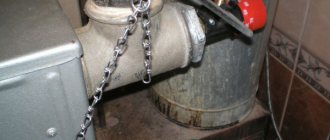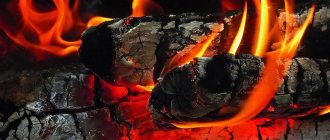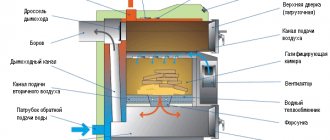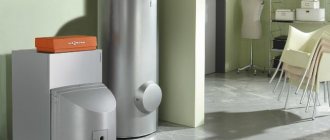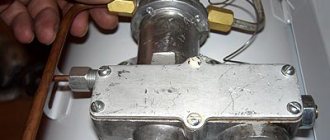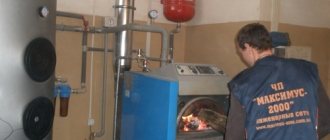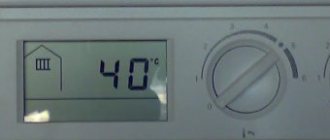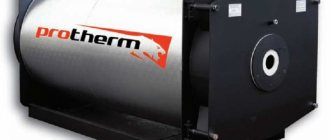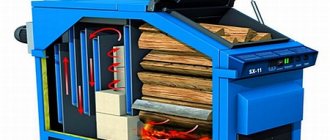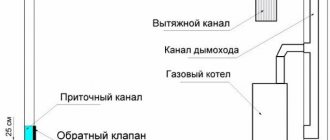Heating boiler efficiency
The efficiency of a heating boiler is the ratio of the useful heat consumed to produce steam (or hot water) to the available heat of the heating boiler. Not all the useful heat generated by the boiler unit is sent to consumers; part of the heat is spent on its own needs. Taking this into account, the efficiency of a heating boiler is distinguished by the heat generated (gross efficiency) and by the heat released (net efficiency).
The difference between the generated and released heat is used to determine the consumption for auxiliary needs. Not only heat is consumed for its own needs, but also electrical energy (for example, to drive a smoke exhauster, fan, feed pumps, fuel supply mechanisms), i.e. consumption for own needs includes the consumption of all types of energy spent on the production of steam or hot water.
As a result, the gross efficiency of a heating boiler characterizes the degree of its technical perfection, and the net efficiency characterizes its commercial profitability. For a boiler unit, gross efficiency, %: according to the direct balance equation:
ηbr = 100 Qpol / Qpp
where Qfloor is the amount of useful heat, MJ/kg; Qрр — available heat, MJ/kg;
according to the reverse balance equation:
ηbr = 100 - (qу.г + qх.н + qн.о)
where qу.г, qх.н, qн.о - relative heat losses with exhaust gases, from chemical incomplete combustion of fuel, from external cooling.
Then the net efficiency of the heating boiler according to the reverse balance equation:
ηnet = ηbr - qs.n
where qс.н is energy consumption for own needs, %.
The determination of efficiency using the direct balance equation is carried out mainly when reporting for a separate period (decade, month), and using the reverse balance equation - when testing a heating boiler. Calculating the efficiency of a heating boiler using reverse balance is much more accurate, since the errors in measuring heat losses are smaller than in determining fuel consumption.
Dependence of boiler efficiency ηк on its load (D/Dnom) 100
qу.г, qх.н, qн.о - heat losses with exhaust gases, from chemical and mechanical incomplete combustion, from external cooling and total losses.
Thus, to improve the efficiency of a heating boiler, it is not enough to strive to reduce heat losses; It is also necessary to completely reduce the consumption of thermal and electrical energy for own needs, which amount on average to 3...5% of the heat available in the boiler unit.
The change in efficiency of a heating boiler depends on its load. To construct this dependence (Fig.), you need to subtract from 100% sequentially all losses of the boiler unit, which depend on the load, i.e. qу.г, qх.н, qн.о. As can be seen from the figure, the efficiency of a heating boiler at a certain load has a maximum value. Operating the boiler at this load is most economical.
The production plant is ready to carry out a comprehensive modernization of your boilers with the installation of highly efficient, economical SF gas burners, as well as the latest boiler control and safety automation.
Preliminary selection of SF gas burners for a range of boilers
Catalog of gas burners SF (technical characteristics)
Contact us and we will offer you specific modernization options with cost, timing and economic effect:
- Call by phone
- Write by email -
Calculation of the boiler heat balance
Boilers, like other heating installations, do not use all the heat that is released during fuel combustion. Quite a large part of the heat is lost along with combustion products into the atmosphere, some is lost through the boiler body and a small part is lost due to chemical or mechanical underburning. Mechanical underburning refers to heat loss due to failure or entrainment of ash elements with unburnt particles.
The heat balance of a boiler is the distribution of heat that is released during fuel combustion, to useful heat used for its intended purpose, and to heat losses that occur during the operation of heating equipment.

Diagram of the main sources of heat loss.
The reference value of heat gain is taken to be the value that could be released at the lowest calorific value of combustion of the entire fuel.
If the boiler uses solid or liquid fuel, then the heat balance is calculated in kilojoules relative to each kilogram of fuel consumed, and when using gas - relative to each cubic meter. In both cases, the heat balance can be expressed as a percentage. Heat balance equation The heat balance equation of a boiler when burning gas can be expressed by the following formula:

Optimal load parameters ensure high performance of the heating system.
- QT=Q1+Q2+Q3+Q4+Q5+Q6;
- where QT is the total amount of thermal heat that entered the boiler furnace;
- Q1 - useful heat, which is used to heat the coolant or produce steam;
- Q2 - heat loss that goes along with combustion products into the atmosphere;
- Q3 - heat loss associated with incomplete chemical combustion;
- Q4 - heat loss due to mechanical underburning;
- Q5 - heat loss through the walls of the boiler and pipes;
- Q6 - heat loss due to the removal of ash and slag from the furnace.
As can be seen from the heat balance equation, when burning gaseous or liquid fuels, there are no values of Q4 and Q6, which are characteristic only of solid fuels.
If the heat balance is expressed as a percentage of the total heat (QT=100%), then this equation takes the form:
- 100=q1+q2+q3+q4+q5+q6.
If you divide each term of the heat balance equation from the left and right sides by QT and multiply it by 100, you get the heat balance as a percentage of the total amount of heat received:
- q1=Q1*100/QT;
- q2=Q2*100/QT and so on.
If liquid or gaseous fuel is used in the boiler, then there are no losses q4 and q6, the boiler heat balance equation in percentage takes the form:
- 100=q1+q2+q3+q5.
Each type of heat and equation should be considered in more detail.
Heat that was used for its intended purpose (q1)
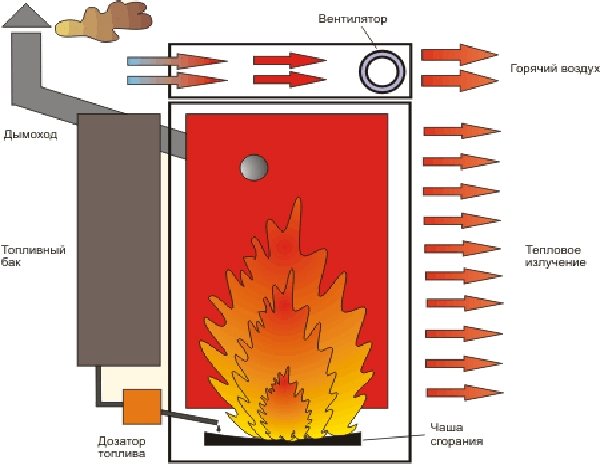
Scheme of the operating principle of a stationary heat generator.
The heat that is used for its direct purpose is considered to be that which is spent on heating the coolant, or producing steam with a given pressure and temperature, which is calculated from the temperature of the water entering the boiler economizer. The presence of an economizer significantly increases the amount of useful heat, as it makes it possible to use the heat contained in the combustion products to a greater extent.
When the boiler operates, the elasticity and steam pressure inside it increases. The boiling point of water also depends on this process. If under normal conditions the boiling point of water is 100°C, then with increasing steam pressure this figure increases. In this case, the steam that is in the same boiler along with boiling water is called saturated, and the boiling temperature of water at a given saturated steam pressure is called the saturation temperature.
If there are no water droplets in the steam, then it is called dry saturated steam. The mass fraction of dry saturated steam in wet steam is the degree of steam dryness, expressed as a percentage. In steam boilers, steam humidity ranges from 0 to 0.1%. If the humidity exceeds these indicators, the boiler does not operate in optimal mode.
The useful heat that is spent on heating 1 liter of water from zero temperature to boiling point at constant pressure is called the enthalpy of the liquid. The heat consumed to convert 1 liter of boiling liquid into a vapor state is called the latent heat of vaporization. The sum of these two indicators is the total heat content of saturated steam.
Heat loss with combustion products escaping into the atmosphere (q2) This type of loss as a percentage shows the difference in the enthalpy of the flue gases and the cold air entering the boiler. The formulas for determining these losses differ when using different types of fuel substances.
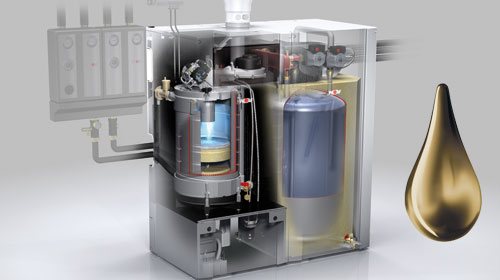
Burning fuel oil leads to heat loss due to chemical underburning.
When using solid fuel, losses q2 are:
- q2=(Ig-αg*Iv)(100-q4)/QT;
- where Ig is the enthalpy of gases escaping into the atmosphere (kJ/kg), αg is the excess air coefficient, Iв is the enthalpy of air required for combustion at the temperature at which it enters the boiler (kJ/kg).
The indicator q4 is introduced into the formula because the heat released during the physical combustion of 1 kg of fuel must be taken into account, and not for 1 kg of fuel entering the furnace.
When using gaseous or liquid fuel, the same formula looks like:
- q2=((Ig-αg*Iv)/QT)*100%.
Heat loss with flue gases depends on the condition of the heating boiler itself and the operating mode. For example, when manually loading fuel into the firebox, heat losses of this type increase significantly due to the periodic influx of fresh air.
Thermal energy losses with flue gases escaping into the atmosphere increase with increasing temperature and the amount of consumed air. For example, the temperature of gases escaping into the atmosphere in the absence of an economizer and air heater is 250-350°C, and in their presence - only 120-160°C, which increases the amount of useful heat several times.
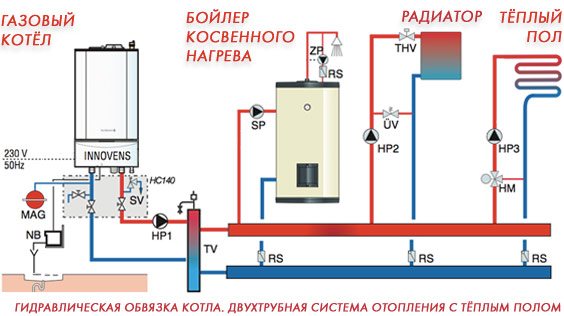
Boiler piping diagram.
On the other hand, insufficient temperature of the exhaust combustion products can lead to the formation of water vapor condensation on heating surfaces, which also affects the formation of ice build-up on chimneys in winter.
The amount of air consumed depends on the burner type and operating mode. If it is increased compared to the optimal value, then this leads to a high air content in the exhaust gases, which additionally carries away some of the heat. This is an inevitable process that cannot be stopped, but can be brought to minimum values. In modern realities, the air consumption coefficient should not exceed 1.08 for burners with full injection, 0.6 for burners with incomplete air injection, 1.1 for burners with forced supply and mixing of air, and 1.15 for diffusion burners with external mixing. The presence of additional air leaks in the furnace and boiler pipes leads to an increase in heat loss with the exhaust air. Maintaining air flow at an optimal level allows you to reduce the q2 value to a minimum.
Related article: When to install doors during renovation: before and after finishing
To minimize the q2 value, it is necessary to promptly clean the external and internal surface of the boiler, ensure that there is no scale, which reduces the transfer of heat from the burned fuel to the coolant, comply with the requirements for the water used in the boiler, ensure that there is no damage to the boiler and pipe connections so as not to allow air flow. The use of additional electric heating surfaces in the gas path consumes electricity. However, the savings from optimal fuel consumption will be much higher than the cost of electricity consumed.
Heat loss from chemical underburning of fuel (q3)
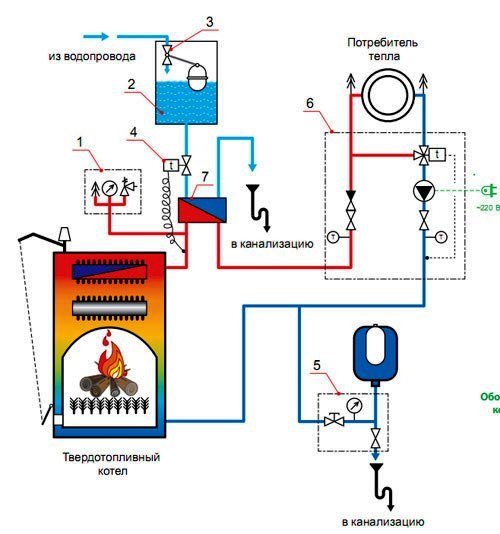
This type of circuit protects the heating system from overheating.
The main indicator of incomplete chemical combustion of fuel is the presence of carbon monoxide (when using solid fuel) or carbon monoxide and methane (when burning gaseous fuel) in the exhaust gases. Heat losses from chemical underburning are equal to the heat that could be released during combustion of these residues.
Incomplete combustion of fuel depends on a lack of air, poor mixing of fuel with air, a decrease in the temperature inside the boiler, or when the flame of burning fuel comes into contact with the walls of the boiler. However, an excessive increase in the amount of incoming oxygen not only does not guarantee complete combustion of the fuel, but can disrupt the operation of the boiler.
The optimal content of carbon monoxide at the outlet of the furnace at a temperature of 1400°C should be no more than 0.05% (in terms of dry gases). With these values, heat loss from underburning will range from 3 to 7%, depending on the fuel. Lack of oxygen can bring this value up to 25%.
But it is necessary to achieve such conditions that there is no chemical underburning of the fuel. It is necessary to ensure optimal air flow into the firebox, maintain a constant temperature inside the boiler, and ensure thorough mixing of the fuel mixture with air. The most economical operation of the boiler is achieved when the carbon dioxide content in the combustion products escaping into the atmosphere is 13-15%, depending on the type of fuel. With an excess of air intake, the carbon dioxide content in the exhaust smoke can decrease by 3-5%, but heat loss will increase. During normal operation of heating equipment, losses q3 are 0-0.5% for pulverized coal and 1% for layer fireboxes.
Article on the topic: Design of a children's room for a girl. Photos of interiors
Heat loss from physical underburning (q4) This type of loss occurs due to the fact that unburned fuel particles fall through the grate into the ash pan or are carried away along with the combustion products through the pipe into the atmosphere. Heat loss from physical underburning directly depends on the design of the boiler, the location and shape of the grate, the draft force, the condition of the fuel and its sinterability.
The most significant losses are from mechanical underburning during layer combustion of solid fuel and excessively strong draft. In this case, a large number of small unburned particles are carried away along with the smoke. This is especially evident when using heterogeneous fuel, when small and large pieces of fuel alternate in it. The combustion of each layer is inhomogeneous, since small pieces burn faster and are carried away with the smoke. Air enters into the resulting gaps, which cools large pieces of fuel. At the same time, they are covered with a slag crust and do not burn out completely.
Heat losses due to mechanical underburning are usually about 1% for pulverized coal fireboxes and up to 7.5% for layer fireboxes.
Heat loss directly through the walls of the boiler (q5) This type of loss depends on the shape and design of the boiler, the thickness and quality of the lining of both the boiler and the chimney pipes, and the presence of a heat-insulating screen. In addition, the design of the firebox itself, as well as the presence of additional heating surfaces and electric heaters in the smoke path, have a great influence on losses. These heat losses increase in the presence of drafts in the room where the heating equipment is located, as well as from the number and duration of opening of the firebox and system hatches. Reducing the amount of losses depends on the correct lining of the boiler and the presence of an economizer. Thermal insulation of pipes through which exhaust gases are discharged into the atmosphere has a beneficial effect on reducing heat loss.
Heat loss due to the removal of ash and slag (q6) This type of loss is typical only for solid fuel in the lump and dust state. When it is underburned, particles of uncooled fuel fall into the ash pan, from where they are removed, taking with them some of the heat. These losses depend on the ash content of the fuel and the ash removal system.
The heat balance of a boiler is a value that shows the optimal and economical operation of your boiler. Based on the heat balance, you can decide on measures that will help save burned fuel and increase the efficiency of heating equipment.
The best posts
- How to make a plasterboard box in the bathroom - step-by-step instructions
- Drywall figures or how to make the interior stylish and fashionable
- DIY decorative corner fireplace made of plasterboard
- How to join drywall in corners and the process of building a decorative niche
- Socket boxes for drywall: correct selection and installation
- How to cover a radiator with plasterboard without losing heat in the room
- Grouting drywall joints: materials and techniques for performing the work
- DIY plasterboard ceiling installation - video tutorials and installation instructions
